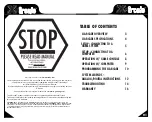
Option
Description
Buzzer Control
The buzzer is a local signal of the instrument. To enable the instrument buzzer, select
the box and do the steps that follow:
1.
Select MEASUREMENT VALUE USED and then NO INPUT VALUE SELECTED.
Select a measurement parameter of the connected sensors to associate to the
buzzer control.
2.
Set the trigger level for the buzzer:
• Action level: sets the range of the measurement parameter where the buzzer
operates.
• Upper level: sets the buzzer to occur when the measurement parameter is higher
than the set point value.
• Lower level: sets the buzzer to occur when the measurement parameter is lower
than the set point value.
Analog outputs
Select the analog output 1 to 6, and set the parameters that follow:
1.
Select MEASUREMENT VALUE USED and then NO INPUT VALUE SELECTED.
Select a measurement parameter of the connected sensors to associate to the
analog output.
2.
Set the scaling levels: set the minimum and maximum mA value for the analog
output.
3.
Hold: select the box to set a fixed mA value for the selected output.
Data import and export
Select Data in the navigation bar to set the data import and export settings.
1.
In the main menu select
Data
, then select
Export
2.
Select an option.
Option
Description
Use start date
Sends all data with the selected start date to the USB drive.
Include spectra in export
Sends spectra to the USB drive.
Split files and limit file sizes
Splits a large file into several smaller files. Sends the files to the USB
drive.
Remember last date for next
export
The date from the last exported measured value is saved. This date is
the next start date of the next export.
Start export
Starts the selected export.
3.
Push
USB Logging
, then select "Enable logging on USB stick" to save the data on the
connected USB flash drive in addition to the internal micro SD card.
Note: To prevent data loss, make sure to enable and disable this option each time a USB drive is connected or
disconnected.
4.
Push
Import
to install new sensor firmware. Refer to the manufacturer's website for additional
information.
5.
Push
Support information
to send the support information to the USB drive. This information will
help technical support.
6.
Push
Recovery Point
to set a recovery point. The user can make, delete or restore a recovery
point. When a recovery point is made all of the controller settings are saved to it. This menu also
shows the default factory settings.
Note: The manufacturer recommends to make a recovery point each time the settings are changed.
7.
Push
Software Update
to install a new software version. Copy the new software version to a
USB flash drive. Save the unzipped files in a subdirectory on the top level of the USB drive. When
English
19
















































